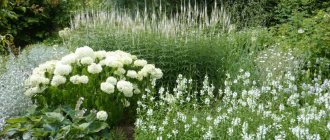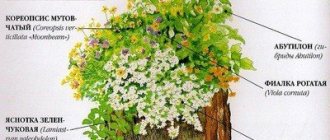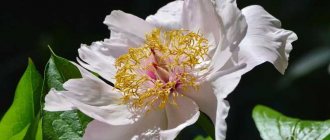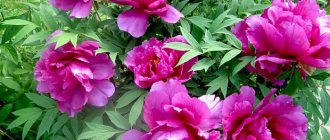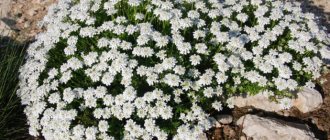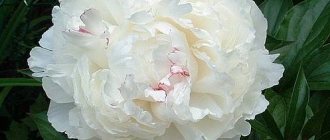Peonies are very ancient inhabitants of gardens. And although every plant is unique, the peony is special. They are deservedly loved by designers, breeders and gardeners all over the world. In Asian countries, the flower is considered a talisman for good luck and prosperity, and healers use a tincture from it for a dozen diseases. The flowering time is June, then the flower becomes the real king of the garden. Peony is not only incredibly beautiful, but also completely unpretentious. Even a novice gardener can grow it.
It is impossible to resist the variety of forms, varieties and aromas of this wonderful plant. By the number of stems you can determine the age of the blooming miracle. The seven-year-old plant has more than forty stems. The leaves are large and complex. In different varieties they can be wide or narrow, and there are even needle-shaped ones. The diameter of the flowers also depends on the species diversity, ranging from 12 to 27 cm. First, the flowers bloom in the center of the bush, then the side buds. A complex rhizome has three types of roots: storage, suction and adventitious.
Application in landscape design
Due to its beauty and lushness of the bush, peony is planted near bodies of water. During flowering, reflected in the water, it turns the landscape into a painting by Flemish artists. The incredible variety of shades and perfection of shapes significantly distinguish peony from other flower crops. The bushes are planted quite closely to each other. Blooming flowers merge into one perfect picture. By using varieties that change color towards the end of flowering, you can add variety to your garden. This phenomenon does not allow the garden to acquire a bored look, and the reflection of flowers in the water fascinates and touches.
A peony at the entrance to a garden, house or near a gazebo creates a romantic mood. But one color, even the brightest, will not bring the same aesthetic pleasure as a skillfully selected tandem or ensemble. Welcoming guests in combination with a contrasting color scheme (warm and cold), peony looks even more delicate and refined. You can use seasonal decorative blocks. Then the emphasis on flowering moves around the estate. The garden seems to live its own life.
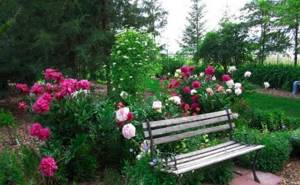
And although the monochrome composition is always relevant, and the large size of the color spot is actively used by landscape designers, multi-color also does not lose its position. The diversity of the color palette helps to plant several shades of peony together, then the flower garden does not turn into one bright spot, but serves as a color stretcher. Then you can consider all its nuances and tones. This makes it possible to appreciate the depth and richness of color.
Because of its beauty and picturesqueness, peony often outshines its neighbors and many gardeners are wary of placing them in mixborders. The solution in this case is a flower garden group. This option for designing a flower bed involves planting several (mostly 3-5) perennials, blooming one after another. It is important that the plants retain their decorative properties after flowering and do not spoil the presentability of the entire group. This, in its own way, is spectacular in that quantity when the peony can show itself in all its glory. It will look more memorable.
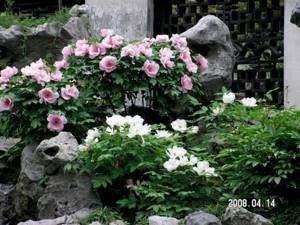
Low-growing, drought-resistant varieties look good in rock gardens. Thin-leaved peony and Crimean peony beautifully frame the stones and fit into the overall style of the Japanese stone flowerbed.
Decorate garden paths with a composition of peony and primroses (crocus, tulips, galanthus, reticulated iris, daffodils and others). It is important to create continuity of flowering here. By skillfully selecting plants, all paths to the garden or house will beautifully frame and divide the area, decorating it with flowering from April to November. Astilbe, lilies, godetia, a variety of petunias, and zinnia will help with this.
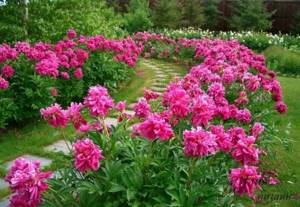
By giving preference to the tree peony, you can contemplate the wonderful contrast against the background of golden and crimson leaves in the fall. The dark leaves have a purple glow. Do not forget about the characteristics of the herbaceous peony; after precipitation, the bush disintegrates and may lose its decorative effect. To do this, gardeners install special metal structures to support the perennial. These can be special shapes, in the form of a butterfly, or geometric shapes.
The narrow shape of the leaves, traditional for a Japanese-style garden, is used to decorate a rock garden. Harmony and naturalness, as if in the lap of nature, are emphasized by dwarf representatives of conifers (juniper, pine, thuja). This helps create an interesting, bright and rich look.
Variety of species and varieties
In order for the design of a flower bed with peonies to meet initial expectations, and the final result to be successful, it is necessary to understand the huge number of species and varieties of these amazing plants. Knowing the so-called hardware, you can choose the most suitable and pleasing option for your garden. Peonies are classified according to the following criteria:
- by origin and form;
- according to the shape of the buds;
- according to flowering time.
In total, there are 4.5 thousand varieties of herbaceous peonies in the world, all the rest are tree-like, which in turn are divided into three groups. There are Japanese ones, distinguished by double flowers, large leaves and buds of various shades, European ones, with excellent frost resistance, as well as hybrid ones, impressive with the original yellowish color of the buds.
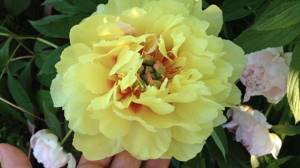
Herbaceous peonies are even more versatile. To keep them wild for as long as possible, they are most often planted in groups of varieties with different flowering periods. The decoration of any garden will be evasive, white-flowered, medicinal, narrow-leaved peonies, blooming in turn from May to July. True aesthetes also pay attention to the shape of the buds. According to this feature, peonies are:
- non-double (straight stems and large flowers);
- Japanese (beautiful flowers of a transitional type, distinguished by modified stamens resembling delicate petals);
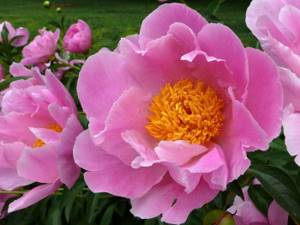
semi-double (stamens gracefully arranged in a circle, alternating with regular petals, which looks very light and airy); double (wide petals, creating several rows around the center and transforming into different forms of inflorescences, depending on the subspecies);
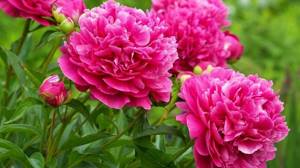
anemone-shaped (the center of the bud consists entirely of modified stamens, and the petals are arranged in two or more rows).
Given such an impressive variety, whatever the gardener’s choice, peonies in the landscape design of a summer cottage (photo) will look amazing in any case.
Combination with other plants
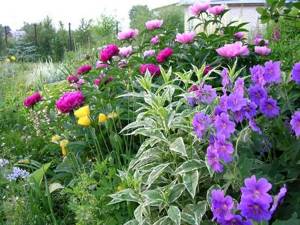
It is difficult to combine the yellow-flowered representative with other crops. This shade is not included in the generally accepted range; it is self-sufficient. Such varieties are planted as tapeworms. This is an excellent combination with a green lawn or coniferous plants. In mixborders, peony is combined with delphinium, helenium, and perennial asters. Double varieties with their heavy stems support their neighbors.
Luxurious peonies harmonize perfectly with white decorative onions. Its heads are not buried in the bright splendor of the “king of the garden”, but act as a contrast and look quite touching. Blood red heuchera and carnation make wonderful company with white and coral peonies. Barberry bushes and dark greenery gracefully shade and highlight the delicate pink buds.
Irises, poppies, honeysuckle, lilies, and bells set accents and create an appropriate contrast with peony. Tall and dwarf plants with small inflorescences are acceptable in compositions. Deciduous decorative plants are often planted next to the peony; they play the role of a kind of background. Juniper bushes and tall trees also become a backdrop for bright and rich peony flowers.
When combining peonies in one composition, do not forget about the need for a decent distance between them, for the convenience of loosening the soil. What is so necessary for flowering perennials.
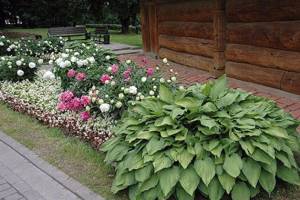
The “King of the Garden” is placed in groups of three bushes at the corners of the lawn, and its perimeter is planted with bergenia, primrose, daisies, mantle and other low-growing representatives of the flora. Foxglove and delphinium are used as accents to soften the transition.
Flowerbed with peonies diagram
It’s worth deciding what peonies go with. It is important to determine the compatibility of different flowers, because a flower bed with peonies should be decorative all season.
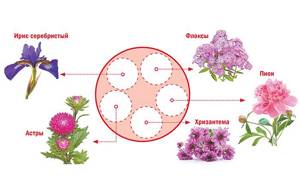
Flowerbed with peonies diagram
Yellow peonies
Planning any flower garden requires you to follow several important rules:
- Combination with the overall landscape design of the site;
- Use of terrain features (emphasize advantages or hide disadvantages);
- Planting density;
- Duration of flowering of each plant;
- Plant such plants together so that their flowering is continuous throughout the season.
To comply with all these tricks, an individual approach to each project is required. Here it is important to take into account the available space for location, lighting, soil composition, the presence of nearby buildings, trees, shrubs, as well as the terrain.
Important! When choosing a location, it is necessary to take into account that peonies do not like prolonged shading, stagnation of moisture in the soil, acidic and heavy soil, and also do not tolerate peat fertilizers.
Several approximate planting schemes for peonies:
- In the center is a group of 3-5 peonies of the same variety, and around there is lawn grass or any ground cover plants.
- Peonies go well with hybrid tea varieties of roses. While the roses are forming buds, the peonies are already beginning to bloom. When the peonies fade, the roses pick up the baton, and the dark green narrow leaves of the peonies serve as an excellent background for them. This is an example of a lawn with peonies and roses.
- Mixborder of dominant peonies (the number of bushes depends on the size of the flower bed) + garden geranium + mantle + decorative onion + aquilegia.
- You can grow a continuous flowering bed from peony (1 pc.) + Siberian iris (4 pcs.) + large rhizomatous geranium (4 pcs.) + sedum (4 pcs.) + yarrow (1 pc.) + switchgrass (1 pc. ) + common chinstrap (1 pc.).
Landing and travel
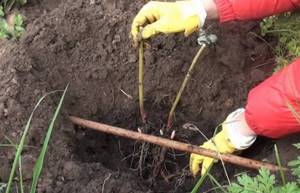
The “king of the garden” is planted or replanted in spring or autumn. The spring period is very short, you need to have time to carry out all the work before increased growth. This is why amateur gardeners do everything in the fall. The plant loves loamy soil, which has enough organic fertilizers. If there is a possibility of storm water and melt water entering, then drainage is vital. The depth of the hole is half a meter deep and the same width.
The plant is unpretentious, but for annual abundant flowering it needs good care. It happens that the peony does not bloom. There are several reasons for this. The main problem may be in the wrong place for planting and in the planting itself. The peony rhizome should be sufficiently buried in the ground. Such a flower can be identified even without flowering; it has a sickly appearance. Complete pruning after flowering is strictly prohibited. This way the plant is deprived of developing buds. If the procedure is carried out correctly, two or three leaves and the lower part of the peduncle remain. They are pruned at the root only in the fall. For the winter, the plant is well protected from the cold.
Fungal diseases pose a danger to the plant. Most often they appear due to a lack of minerals and weakening of the peony. This occurs from lack of care and improper early pruning. Regular watering and loosening the soil of young plants, as well as watering older bushes, in most cases, prevents insect pests from affecting the peony.
Flower garden with peonies
Before you start drawing up a flower garden plan, you need to know that:
- Peonies grow in one place for many years and cannot be replanted often, so the location must be selected very carefully.
- The young plant will gain strength for several years and only then will it take its rightful place among the flowers.
- Peonies are always the dominant flowers, so it is better to choose one variety and select companions for it.
- The flowering period for peonies begins in mid-May. Herbaceous varieties bloom for about two weeks, and tree varieties with good care can bloom for 3-4 weeks.
- When planting, it is necessary to take into account that adult bushes need support during the flowering period. Huge inflorescences bend the stems to the ground with their weight. The bush takes up a lot of space.
- After the peonies have bloomed, their dark green, narrow and long leaves will serve as an excellent background for the flowers of other plants.
- Peonies look great when grown in groups or single bushes among a green lawn. In this case, you can choose several varieties of different flowering periods and colors that harmoniously complement each other.
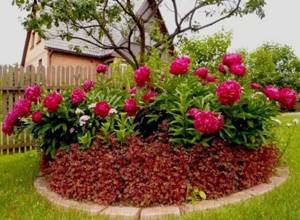
Flowerbed with peonies
Important! The richness of colors and shapes in hybrid peonies is so enormous that it is better to choose two varieties for a group that highlight the beauty of each other in color and shape, rather than create a cacophony of many magnificent, but unsuitable varieties in color.
Considering all these features of creating a flower garden with peonies, you can easily determine the location and shape of the flower garden.
What colors do peonies go with?
When creating a flower garden, it is important to provide the right color solutions. When choosing what to wear, people almost always pay attention to the color compatibility of costume ensemble items and accessories. When planting flowers in the garden, some gardeners do not think about it, meanwhile, color disharmony makes the flower bed unaesthetic. Neighbors for peonies must be selected depending on the color of the petals of a particular variety.
- Next to peonies of rich red or wine color, flowers of the same bright red or red-lilac hue will look good. White flowers, such as decorative onion inflorescences, will look contrasting and attractive against the background of burgundy peonies.
- With peonies, whose petals resemble coral in color, flowers of a brighter and richer red tone will look good: carnations, heuchera.
- It would be wise to emphasize the solemnity of white peonies by placing contrasting honeysuckle, poppy, bells, daylilies, and irises next to them.
- Pink peonies harmonize with hellebore. Their tenderness can be emphasized by barberry and thuja.
- If you are lucky enough to become the owner of a yellow variety of peonies, you can plant bells or irises next to them, contrasting with them in color. They go well with flowers of red shades.
It is not recommended to plant different varieties of peonies next to each other, even if they are in harmony in color.
What to plant next to irises
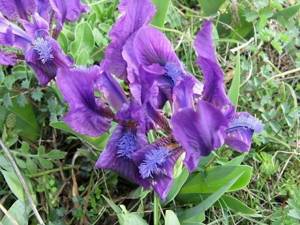
Iris is a shade-tolerant, decorative, fairly tall crop that begins to bloom closer to summer. Based primarily on these prerequisites, we will choose neighbors for her, especially since the iris neighbor is very accommodating.
Since irises will look great with annuals, perennials, and even with ornamental shrubs, the whole question when creating compositions with irises will concern only your aesthetic preferences - whether you like monochrome and minimalism, or whether you prefer cheerful and rich color compositions.
So, based on the contrast of color and size, irises can be planted together with lilies, bergenia or poppies. In a monochrome flowerbed, you can add decorative grasses to them. A flowerbed of just irises of one or several varieties of various colors will look great. Lavender, phlox, delphinium, clematis, daffodils, tulips, sedum, heather, lupine, Rogers, nasturtium, petunia go well with irises...
Tall varieties of irises usually appear vertically and in the background in a mixborder, while miniature ones can be placed both in borders and on rocky hills.
Perhaps, the only unfortunate thing would be the proximity of irises to roses - at a minimum, they will “block” each other visually and will not allow you to fully enjoy the view of either crop.
Species and varietal diversity
In total, there are about 5 thousand varieties of peony. Conventionally, three categories can be distinguished. They are based on the origin, as a result of selection manipulations, of plant forms:
1. Peony officinalis:
- rubra of captivity,
- rosea captivity,
- alba captivity,
- lobata.
2. Peony milky-flowering:
- simple, not double (Chinese peony, a la mode, Nancy, Aritina Nosen Glory),
- semi-double (Miss America, cytheria),
- terry (raspreri sande, Monsieur Jules Elie, Henry Boxtos, ballerina, Gaudi, Illini bell),
- Japanese (karara, pearl scattering, Velta Atkison, Hot Chocolit, Barington Bell),
- anemoids (snow mountain, root glue, lastres, sable).
3. Interspecific hybrids



